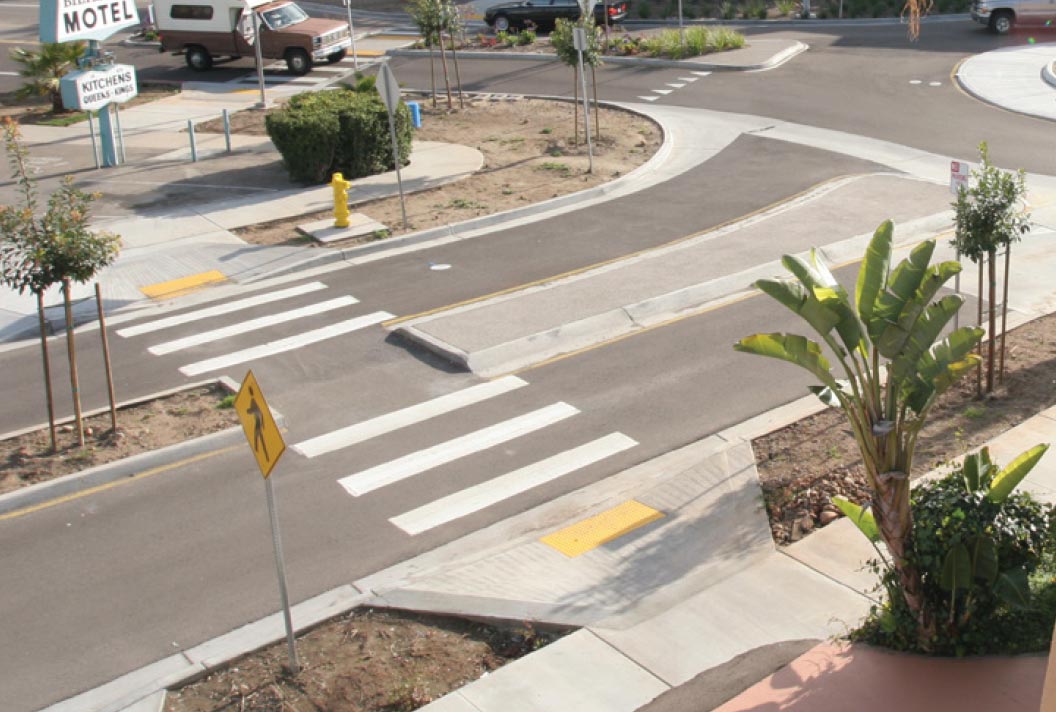The Highway Safety Improvement Program (HSIP) is one of the largest and most important federal funding sources for transportation projects. Since 2005, the program has funded tens of thousands of road safety projects and has been credited with drastically reducing crash frequency and severity across the country.
But contrary to its name, HSIP funds aren’t just for state-owned highways. They can be used on any public road, including state, county, and local roads, and, importantly, they can be used for bicyclist and pedestrian safety projects, too.
Many states are already doing this. In 2020, states obligated more than $165 million in HSIP funds to 313 projects focused on bicyclist and pedestrian safety, including the installation of crosswalks, lighting, and rectangular rapid flashing beacons. New York spent almost half its total HSIP funds on pedestrian safety.
Still, the lion’s share of HSIP dollars continues to be spent on vehicle-centric infrastructure—or even projects unrelated to safety. This could soon change, however, as amendments to the program under the Bipartisan Infrastructure Law (BIL) encourage (and in some cases, obligate) states to fund pedestrian safety projects. Here’s what you need to know.
What type of funding is the Highway Safety Improvement Program?
HSIP is a core federal formula grant program, meaning funding is allocated to states, tribal organizations, and transit agencies based on formulas set by Congress. This differs from discretionary grant programs like the Safe Streets for All (SS4A) and Transportation Alternatives (TA) set-aside, which require organizations to apply and compete for funds.
How much is available?
Like many federal transportation funding programs, the BIL significantly increased funding to HSIP, providing nearly $3 billion to states in 2022, and $15.6 billion over the next five years (a ~34% increase over FAST Act amounts). The totals apportioned to each state can be found on the FHWA’s website.
How can the funds be used?
According to eligibility guidance issued by the FHWA in February 2022, the purpose of HSIP is to “achieve a significant reduction in fatalities and serious injuries on all public roads, including non-state-owned public roads and roads on tribal land.”
Interpretations have historically been broad and included everything from cement barriers to minimize roadway departures to public awareness campaigns to boost seat belt use. That said, the new guidelines put a strong emphasis on vulnerable road user safety and urge states to prioritize projects that “increase safety, equity, accessibility, and connectivity” for non-motorized and transit users.
What’s the new Vulnerable Road User Special Rule?
One of the most significant changes to HSIP is the new Vulnerable Road User Special Rule, which requires states where bicyclist and pedestrian fatalities make up 15% or more of all traffic fatalities to spend a proportional amount of their HSIP funds (i.e. 15%) on safety projects specifically focused on those groups—or pay it back. The map below shows which states will be affected by the new rule in 2022.
Also new under the BIL is the requirement for every state to complete a vulnerable road user safety assessment within two years of enactment. This entails a quantitative analysis of vulnerable road user fatalities and injuries for the purpose of identifying high-risk locations, coupled with “a program of projects or strategies to reduce safety risks.” These plans are to be published on a new USDOT website, along with action items and performance indicators.
Can funds still be transferred out of HSIP?
States still have the authority to use up to 50% of the money they receive through HSIP for other transportation uses—something 23 states did in 2021. However, the latest guidance discourages this, noting that “the BIL substantially increased funding for core apportioned programs,” and asking states to “consider whether there remains a need to transfer HSIP funds to other programs.” States can also transfer funds into HSIP to maximize their safety dollars.
Is there a matching requirement?
Yes, however unlike many federal transportation funding programs, the federal share of HSIP is 90% rather than 80%. Additionally, thanks to a BIL amendment, HSIP funds can now be used to cover the non-federal share of a transportation alternatives (TA) set-aside project, allowing bicyclist and pedestrian safety projects to be funded entirely by the federal government, rather than just 90%. Certain safety projects, like roundabouts, pavement markings, and warning signs, are also eligible for 100% federal share.
As pedestrian fatalities and serious injuries continue to reach new, unfathomable heights, it is critical that agencies act to ensure they are maximizing funding for safety improvements. Increases to HSIP under the BIL mean that more funding is available than ever before, marking a huge opportunity, and potential turning point, for transportation safety in the U.S. Let’s not squander it.
Resources
HSIP Eligibility Guidance – February 2022 (FHWA)
Highway Safety Improvement Program Fact Sheet (FHWA)
Keeping Pedestrians Safe with HSIP (FHWA)
Getting a Fair Share for Safety with HSIP (League of American Bicyclists)
Updated HSIP Guidance Under BIL (AZDOT)
New Fed. Law Requires Some (But Not All!) States to Improve Bike/Walk Safety (StreetsblogUSA)
